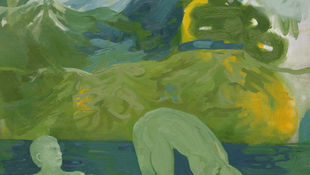
Reimagining Matter In Arte Povera
The 1960s were a decade of intense cultural, political, and artistic transformation across the Western world. In Italy, amid a climate of industrial modernisation, social unrest, and student movements, a new form of radical artistic expression emerged: Arte Povera. Coined by Italian art critic and curator Germano Celant in 1967, the term described a group of artists who eschewed traditional media and techniques in favour of everyday materials and a direct engagement with life and nature. While it was geographically centred in cities like Turin, Milan, and Rome, Arte Povera had far-reaching implications for global contemporary art.

Post-war Italy experienced rapid economic growth during the Italian economic miracle (1950s–1960s), resulting in accelerated urbanisation, consumerism, and technological innovation. Simultaneously, Italy was a locus of intense political engagement, with the rise of leftist student and worker movements culminating in the protests of 1968. Artists of Arte Povera responded to this sociopolitical milieu with a conscious rejection of the commodification of art and the mechanisation of life. They turned instead toward humble, ephemeral, and organic materials as a means to critique both the industrial order and the elitist structures of the art world. Germano Celant's 1967 manifesto "Arte Povera: Notes for a Guerrilla War" positioned the movement as a counter-cultural, anti-establishment artistic insurgency. Drawing from a range of philosophical sources - from Marxism to phenomenology - Celant emphasised spontaneity, process, and the elimination of the boundary between art and life. Celant's central argument was that art should resist systematisation and institutional absorption. He encouraged artists to work with "poor" materials not as a form of asceticism but as a way to reconnect art with human experience, natural processes, and material reality.
Arte Povera drew inspiration from European phenomenology (especially Merleau-Ponty), process philosophy, and ancient notions of alchemy. The emphasis was on transformation, impermanence, and embodiment. There were also parallels with contemporaneous movements, such as American Process Art and Anti-Form (e.g., Robert Morris and Eva Hesse), although Arte Povera retained a uniquely metaphysical and political inflexion. Unlike the slick surfaces of American Minimalism or the rigid geometries of Constructivism, Arte Povera embraced a vast array of unconventional materials - rags, stones, plants, iron, coal, wax, water, and live animals. These materials were selected not only for their symbolic valence but also for their inherent properties: fragility, decay, tactility, and changeability. The artists typically avoided permanent installations and instead created situations or environments that emphasised temporality and transformation. Many works were ephemeral and existed only in the moment of their creation or display.
By the 1970s, many of the movement’s key figures—among them Jannis Kounellis, Michelangelo Pistoletto, and Mario Merz—had achieved international recognition, signalling a broader acceptance of its conceptual and aesthetic provocations across the global art scene. The critical success and international acclaim of Arte Povera introduced a paradox at the heart of its development: the movement that once sought to critique the art institution and resist commodification gradually became institutionalised itself. As major museums and galleries began to collect and exhibit Arte Povera works, and as its artists gained celebrity status, critics noted the movement’s absorption into the very system it had aimed to destabilise. This process of institutionalisation raised concerns about the co-option of radical artistic practices by market forces and cultural capital. Nonetheless, scholars and practitioners continue to assert that Arte Povera’s enduring significance lies not in its resistance to institutional inclusion but in its foundational gestures of material experimentation and conceptual disruption. The movement's emphasis on process over product, its ecological sensitivity through the use of natural and discarded materials, and its challenge to hierarchies of value persist as vital influences in contemporary art discourse.

Initially, Arte Povera was met with scepticism, particularly in an art market increasingly focused on permanence and commodification. Its radical stance found supporters in critical and avant-garde circles, and many of its practitioners gained international recognition by the 1970s. Paradoxically, as Arte Povera gained fame, its anti-institutional ethos came under strain. Critics have pointed out the movement’s eventual absorption into the very art world it sought to critique. Yet others argue that Arte Povera’s true value lies in its legacy of destabilisation, material innovation, and ecological awareness. The movement paved the way for later developments in installation art, relational aesthetics, and eco-art. Its influence is evident in the works of artists such as Doris Salcedo, Olafur Eliasson, and Giuseppe Penone. Contemporary discussions of sustainability, transience, and decolonial aesthetics often echo Arte Povera’s early concerns.
Arte Povera was more than a stylistic turn; it was a philosophical and political redefinition of what art could be. In rejecting both the industrial modernity of its time and the commodified aesthetics of the art market, it forged a space for experimentation, critique, and ecological sensitivity. Over half a century later, its provocations remain as relevant as ever, urging artists and audiences alike to reconsider the materials, meanings, and methods of creative expression.





